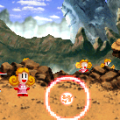After a five year hiatus, the Thunder Force series returned to grace the 32-bit consoles with its fifth title. The hardware update brought about a new change to the series, as the game sprites are now done in 3D, similarly to other shoot-em-up franchises at the time. Unfortunately, the 3D designs have aged a bit poorly, due to blocky polygons and pixelation issues, though the sprites animate well and the backgrounds look nice to somewhat compensate for this.
The story moves away from the fight against ORN as detailed in the previous games. Instead, the Rynex, mostly destroyed at the end of Thunder Force IV, drifts off to Earth. The scientists find this vessel and call it Vasteel. However, the AI created to study this technology, called the Guardian, goes crazy, and so the RVR-01 Gauntlet is sent off to fight it.
The major addition to the gameplay is that you now have ability to use Over Weapons. By using the energy of your CLAWs (or CRAWs, as they’re now called), you can combine them with your weapons and create improved versions of them, which lay waste to everything in their path. The Over Weapons drain CRAW energy though, and when depleted, you either have to wait for them to recharge or replace them in order to use the Over Weapon again. In their weakened state, the CRAWs will disappear if hit by enemy fire. The game also has a new scoring system that rewards you for defeating larger enemies as quickly as possible via score multipliers.
One of the standout elements of Thunder Force V is its really cool boss battles. One such boss, A3 (Armament Armed Arm), transforms between a walker tank, hovercraft, and flying aircraft. Another, Guardian’s Knight, is a Macross-like transforming mech that slashes at you with its huge sword and relentlessly fires at you with a screenful of bullets and a large laser cannon. Some of these are named after heavy metal bands like Deep Purple and Iron Maiden, appropriate given the rocking soundtrack. But no doubt the coolest moment is when you rocket into space, where you’re forced to fight the Fire Leo 04 Rynex – the ship from Thunder Force IV, with a remix of that game’s intro theme rockin’ in the background!
The difficulty level is easier than Thunder Force II and IV, but a bit harder than III. Much of the difficulty is lowered by the absolutely devastating Free Range weapon, that can cut down even the strongest of enemies without much of a problem. Mastery of it will pretty much guarantee an easy play through (except for the very last boss who’s a bastard no matter what, and because you have to fight on a time limit to see the good ending). Without the Free Range, the game becomes more challenging but still remains at a manageable level.
As expected from Technosoft by now, Thunder Force V has a soundtrack worthy of the series. The score is full of catchy melodies and copious amounts of synth rock composed by Tsukumo Hyakutaro. As a treat for fans, the first stage theme “Legendary Wings“ contains a nice little homage to “Back to the Fire“ from the third game.
The two versions for Saturn and PlayStation are fundamentally the same, with a few differences. The Saturn version has the edge in the graphics department, since some of the graphical tricks and touch-ups found in it are missing in the later PlayStation release. For instance, in the third level of the Saturn version, the ground is transparent and reveals a city underneath the rubble. This is completely absent in the PlayStation version, and the ground is completely solid, and also has noticeable texture warping. While the Saturn version generally has more detailed backgrounds, the PlayStation version has slightly better texturing on the bosses, but it’s barely noticeable. In the long run, though, both look pretty ugly. The PlayStation version also adds little bits of pseudo computer code in between the loading segments.
The Saturn version also had two releases, a normal version and a special version containing an extra CD full of remixed Thunder Force music. The PlayStation version (subtitled Perfect System) expands the game a bit with some added features. Among them are an unlockable boss rush mode, an image viewer, and extra CG scenes. It also improves on some of the slowdown present in the Saturn version, although it was so minimal that it wasn’t a huge deal to begin with.
Working Designs brought the game to America under the Spaz label, and made it so you couldn’t truly “beat“ the game unless you set it to the default difficulty level or higher, making “easy“ mode a waste of time. It also fixes up some of the Engrish text. The Japanese Game Over screen says “Try to Next Chance“, as opposed to “Pilot Error“ in the English version. However, each boss is introduced with some bit of speech. For the second boss, the computer voice says, “It was dead, but alive at the same time.“ In the English version, the text was changed to “Alive but dead, it fears nothing and decimates all.“ It makes more sense, but the voice was not fixed to match.
Screenshot Comparisons

